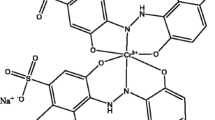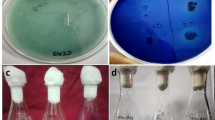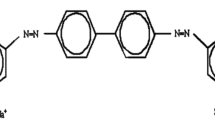Abstract
Acridine orange (AO), a basic carcinogenic fluorochrome dye, is used in the industry for staining. In this study, Gram-positive bacteria, Bacillus cereus M116 (MTCC 5521) dry biomass was tested as an eco-friendly, easily available, and cheap biosorbent for the AO dye removal. We obtained optimum biosorption of AO at a biomass concentration of 0.25 g/L and initial dye concentrations of 50–400 mg/L at neutral to basic pH within the 300 min contact time. Kinetics analysis of the biosorption process was best fitted with the pseudo-second-order reaction type. We also performed the isotherm analysis to predict the nature of the reaction taking place, which was found to follow the Redlich Peterson isotherm model with high determination coefficients. The maximum sorption capacity was 210.46 mg/g of dry biomass. The differential FTIR spectroscopic analysis of pristine and AO-treated Bacillus cereus M116 cells suggested the potential involvement of carbonyl, hydroxyl, and amine groups in the biosorption process. Also, the scanning electron microscopy of the cells after AO removal confirmed a gross surface alteration compared to the untreated cells. Furthermore, Response Surface Model (RSM) analysis with the three-way ANOVA test confirms statistically significant interactions between the dye concentration, pH, and temperature with the biosorption capacity (p < 0.001). Hence, the dry biomass of Bacillus cereus M116 was found to be an effective bio-remedial for the AO removal.

Source: PubChem)





Similar content being viewed by others
References
Aksu Z (2005) Application of biosorption for the removal of organic pollutants: a review. Process Biochem 40:997–1026. https://doi.org/10.1016/j.procbio.2004.04.008
Anjaneya O, Shrishalinath S, Guruprasad K, Nayak AS, Mashetly SB, Karegonder TB (2013) Decolorization of amaranth dye by bacterial biofilm in batch and continuous packed bed bioreactor. Int Biodeterior Biodegrad 79:64–72. https://doi.org/10.1016/j.ibiod.2013.01.006
Award HS, Galwa NA (2005) Electrochemical degradation of Acid Blue and Basic Brown dyes on Pb/PbO2 electrode in the presence of different conductive electrolyte and effect of various operating factors. Chemosphere 61:1327–1335. https://doi.org/10.1016/j.chemosphere.2005.03.054
Bag S, Bardhan A, Bera D, Mitra A, Halder D (2017) Study of adsorption of malachite green on dried Aspergillus versicolor (MTCC280) biomass. J Surf Sci Technol 33:70–78. https://doi.org/10.18311/jsst/2017/16392
Baldikova E, Safarikova M, Safarik I (2015) Organic dyes removal using magnetically modified rye straw. J Magn Magn Mater 380:181–185. https://doi.org/10.1016/j.jmmm.2014.09.003
Bera D, Chattopadhyay P, Ray L (2007) Chromium (VI) biosorption by immobilized biomass of Bacillus cereus M116. J Hazard Subst Res 7:1–19. https://doi.org/10.4148/1090-7025.1034
Bruschweiler BJ, Merlot C (2017) Azo dyes in clothing textiles can be cleaved into a series of mutagenic aromatic amines which are not regulated yet. Regul Toxicol Pharmacol 88:214–226. https://doi.org/10.1016/j.yrtph.2017.06.012
Das SK, Guha AK (2007) Biosorption of chromium by Termitomyces clypeatus biomass. Colloids Surf B 60:46–54. https://doi.org/10.1016/j.colsurfb.2007.05.021
Das SK, Guha AK (2011) Biosorption of Hexavalent chromium by Termitomyces clypeatus biomass: kinetics and transmission electron microscopy study. J Hazard Mater 167:685–691. https://doi.org/10.1016/j.jhazmat.2009.01.037
Denton D, Kumar S (2015) Using the vital dye Acridine orange to detect dying cells in Drosophila. Cold Spring Harb Protoc 6:572–575. https://doi.org/10.1101/pdb.prot086207
Dziubakiewicz E, Buszewski B (2014) Capillary electrophoresis of microbial aggregates. Electrophoresis 35:1160–1164. https://doi.org/10.1002/elps.201300588
Farah JY, El-Gendy NSh, Farahat LA (2007) Biosorption of Astrazone Blue basic dye from an aqueous solution using dried biomass of Baker’s Yeast. J Hazard Mater 148:402–408. https://doi.org/10.1016/j.jhazmat.2007.02.053
Freundlich HMF (1906) Uber dye adsorption in Losungen. J Phys Chem 57:385–470
Garg SK, Triapathi M (2013) Process parameters for decolorization and biodegradation of orange II (acid orange 7) in dye simulated minimal salt medium and subsequent textile effluent treatment by Bacillus cereus (MTCC 9777) RMLAU1. Environ Monit Assess 185:8909–8923. https://doi.org/10.1007/s10661-013-3223-2
Good BH, Martis S, Hallatschek O (2018) Adaptation limits ecological diversification and promotes ecological thinkering during the competition for substitutable resources. Proc Natl Acad Sci USA 115:10407–10416. https://doi.org/10.1073/pnas.1807530115
Gunasekar V, Gowdhaman D, Ponnusami V (2013) Biodegradation of reactive red M5B dye using Bacillus subtilis. Int J ChemTech Res 5:131–135
Hansda C, Chakraborty U, Hussain SA, Bhattacharjee D, Paul PK (2016) Layer-by-layer films and colloidal dispersions of graphene oxide nanosheets for efficient control of the fluorescence and aggregation properties of the cationic dye acridine orange. Spectrochim Acta A Mol Biomol Spectrosc 157:79–87. https://doi.org/10.1016/j.saa.2015.12.006
Hassaninejad-Darzi SK, Mousavi HZ, Ebrahimpour M (2017) Biosorption of Acridine orange and Auramine O dyes onto MCM-41 mesoporous silica nanoparticles using high-accuracy UV-Vis least squares regression. J Mol Liq 248:990–1002. https://doi.org/10.1016/j.molliq.2017.10.126
Hayashi M, Sofuni T, Ishidate M Jr (1983) An application of Acridine orange fluorescent staining to the micronucleus test. Mutat Res Lett 120:241–247. https://doi.org/10.1016/0165-7992(83)90096-9
Ho YS, McKay G (1999) Pseudo-second order model for sorption processes. Process Biochem 34:451–465. https://doi.org/10.1016/S0032-9592(98)00112-5
Horobin RW, Kiernan JA (2002) A handbook of dyes, strains and fluorochromes for use in biological and medicine. Corn’s Biological Stains 10th ed
Huang F, Danga Z, Guoa CL, Lua GN, Roy RG, Liud HJ, Zhanga H (2013) Biosorption of Cd (II) by live and dead cells of Bacillus cereus RC-1 isolated from cadmium-contaminated soil. Colloids Surf B 107:11–18. https://doi.org/10.1016/j.colsurfb.2013.01.062
Huang YT, Lee LC, Shih MC (2018) A study on the pseudo-second-order kinetic equation for the adsorption of methylene blue onto nitric acid-treated rice husk: comparison of linear methods. Int J Sci Res 8:2250–3153. https://doi.org/10.29322/IJSRP.8.6.2018.p7865
Itoh K, Kitada Y, Kabayashi S, Nakanishi M, Yatona C (1998) Demethylation of Acridine orange by Arthrobacter globiformis. Bull Environ Contam Toxicol 60:781–785. https://doi.org/10.1007/s001289900694
Jamee R, Siddique R (2019) Biodegradation of synthetic dyes of textile effluent by microorganisms: an environmentally and economically sustainable approach. Eur J Microbiol Immunol 9:114–118. https://doi.org/10.1556/1886.2019.00018
Kowanga KD, Gatebe E, Mauti GO, Mauti EM (2016) Kinetic, sorption isotherms, pseudo-first-order model and pseudo-second-order model studies of Cu(II) and Pb(II) using defatted Moringaoleifera seed powder. J Phytopharm 5:71–78. https://doi.org/10.1021/ie901150x
Kuppusamy S, Venkateswarlu K, Thavamani P, Lee YB, Naidu R, Megharaj M (2017) Quercus robur acorn peel as a novel coagulating adsorbent for cationic dye removal from aquatic ecosystems. Ecol Eng 101:3–8. https://doi.org/10.1016/j.ecoleng.2017.01.014
Langmuir I (1918) The adsorption of gases on plane surfaces of glass, mica and platinum. J Am Chem Soc 40:1361–1403. https://doi.org/10.1021/ja02242a004
Liu CH, Sahoo SL, Tsao MH (2014) Acridine orange coated magnetic nanoparticles for nucleus labeling and DNA adsorption. Colloids Surf B 115:150–156. https://doi.org/10.1016/j.colsurfb.2013.11.003
Mahalik K, Sahu JN, Anand VP, Meikap BC (2010) Statistical modelling and optimization of hydrolysis of urea to generate ammonia for flue gas conditioning. J Hazard Mater 182:603–610. https://doi.org/10.1016/j.jhazmat.2010.06.075
Mondal NK, Roy S (2016) Optimization study of adsorption parameters for removal of phenol on gastropod shell dust using response surface methodology. Clean Technol Environ Policy 18:429–447. https://doi.org/10.1007/s10098-015-1026-6
Nath J, Ray L (2015) Biosorption of Malachite green from aqueous solution by dry cells of Bacillus cereus M116 (MTCC 5521). J Environ Chem Eng 3:386–394. https://doi.org/10.1016/j.jece.2014.12.022
Nath J, Bag S, Bera D, Ray L (2019) Biotreatment of malachite green from aqueous solution and simulated textile effluent by growing cells (batch mode) and activated sludge system. Groundw Sustain Dev 8:172–178. https://doi.org/10.1016/j.gsd.2018.11.002
Nayak AK, Pal A (2018) Rapid and high-performance adsorptive removal of hazardous Acridine orange from aqueous environment using Abelmoschuses culentus seed powder: single- and multi-parameter optimization studies. J Environ Manag 217:573–591. https://doi.org/10.1016/j.jenvman.2018.03.137
Nejad-Darzi SKH, Samadi-Maybodi A, Ghobakhluo M (2013) Synthesis and characterization of modified ZSM-5 nanozeolite and their applications in adsorption of Acridine orange dye from aqueous solution. J Porous Mater 20:909–916. https://doi.org/10.1007/s10934-012-9668-9
Nhaingo T, Moyo M (2016) Application of Opuntia Ficus-Indica in bioremediation of wastewaters. A Critical Review. J Environ Manag 166:55–72. https://doi.org/10.1016/j.jenvman.2015.10.005
Pan J, Ge X, Liu R, Tang H (2006) Characteristic features of Bacillus cereus cell surfaces with biosorption of Pb(II) ions by AFM and FT-IR. Colloids Surf B 52:89–95. https://doi.org/10.1016/j.colsurfb.2006.05.016
Pan JH, Liu RX, Tang HX (2007) Surface reaction of Bacillus cereus biomass and its biosorption for lead and copper ions. J Environ Sci 19:403–408. https://doi.org/10.1016/s1001-0742(07)60067-9
Peng JS, Tsai WS, Chou CC (2001) Surface characteristics of Bacillus cereus and its adhesion to stainless steel. Int J Food Microbiol 65:105–111. https://doi.org/10.1016/s0168-1605(00)00517-1
Piaskowski K, Swiderska-Dabrowska R, Zarzycki PW (2018) Dye removal from water and wastewater using various physical, chemical, and biological processes. J AOAC Int 101:1371–1384. https://doi.org/10.5740/jaoacint.18-0051
Platero E, Fernandez ME, Bonelli PR, Cukierman AL (2016) Graphene oxide/alginate beads as adsorbents: Influence of the load and the drying method on their physicochemical-mechanical properties and adsorptive performance. J Colloid Interface Sci. https://doi.org/10.1016/j.jcis.2016.12.014
Qadri S, Ganoe A, Haik Y (2009) Removal and recovery of acridine orange from solutions by use of magnetic nanoparticles. J Hazard Mater 169:318–323. https://doi.org/10.1016/j.jhazmat.2009.03.103
Ratner B (2009) The correlation coefficient: its values range between + 1 / − 1, or do they. J Target Meas Anal Mark 17:139–142. https://doi.org/10.1057/jt.2009.5
Redlich O, Peterson DL (1959) A useful adsorption isotherm. J Phys Chem 63:1024–1026. https://doi.org/10.1021/j150576a611
Safarik I, Safarikova M (2010) Magnetic fluid modified peanut husks as an adsorbent for organic dyes removal. Phys Procedia 9:274–278. https://doi.org/10.1016/j.phpro.2010.11.061
Safarik I, Rego LFT, Borovska M, Mosiniewicz-Szablewska E, Weyda F, Safarikova M (2007) New magnetically responsive yeast-based biosorbent for the efficient removal of water-soluble dyes. Enzyme Microb Technol 40:1551–1556. https://doi.org/10.1016/j.enzmictec.2006.10.034
Safarik I, Horska K, Svobodova B, Safarikova M (2012) Magnetically modified spent coffee grounds for dyes removal. Eur Food Res Technol 234:345–350. https://doi.org/10.1007/s00217-011-1641-3
Sekhar CP, Kalidhasan S, Rajesh V, Rajesh N (2009) Bio-polymar adsorbent for the removal of malachite green from aqueous solution. Chemosphere 77:842–847. https://doi.org/10.1016/j.chemosphere.2009.07.068
Shahri FB, Niazi A, Akrami A (2018) Application of full factorial design for removal of polycyclic aromatic dye from aqueous solution using 4A zeolite: adsorption, thermodynamic kinetic studies. Polycycl Aromat Compd 38:141–156. https://doi.org/10.1080/10406638.2016.1173074
Sun L, Fugetsu B (2014) Graphene oxide captured for green use: influence on the structures of calcium alginate and microporousalginic beads and their application to aqueous removal of Acridine orange. Chem Eng J 240:565–573. https://doi.org/10.1016/j.cej.2013.10.083
Upendar G, Dutta S, Bhattacharya P, Dutta A (2017) Bioremediation of Methylene blue dye using Bacillus subtilis MTCC 441. Water Sci Technol 75:1572–1583. https://doi.org/10.2166/wst.2017.031
Acknowledgements
This study was supported by a grant from SERB-(ECR/2016/001127) and by a Calcutta University BI to AG and RUSA 2.0 grant from national higher education mission, Govt. of India to DH. We also acknowledge Ms. Anushree Goswami and Mr. Bodhisatta Sinha for their technical assistance.
Author information
Authors and Affiliations
Corresponding author
Ethics declarations
Conflict of interest
No conflict of interest.
Additional information
Communicated by Erko Stackebrandt.
Publisher's Note
Springer Nature remains neutral with regard to jurisdictional claims in published maps and institutional affiliations.
Supplementary Information
Below is the link to the electronic supplementary material.
203_2021_2355_MOESM2_ESM.eps
Supplementary file2 (EPS 1226 kb) Fig.S2 (a) Lagergren pseudo-first order kinetic plot for AO biosorption (Experimental conditions: C0 = 50 mg/L; 100 mg/L; 400 mg/L; pH:7.0; temperature: 30°C). (b)The values of pseudo-first order kinetics parameter.
Rights and permissions
About this article
Cite this article
Bag, S., Hasan, M.I., Halder, D. et al. Biosorption of organic dye Acridine orange from aqueous solution using dry biomass of Bacillus cereus M116. Arch Microbiol 203, 3811–3823 (2021). https://doi.org/10.1007/s00203-021-02355-x
Received:
Revised:
Accepted:
Published:
Issue Date:
DOI: https://doi.org/10.1007/s00203-021-02355-x




